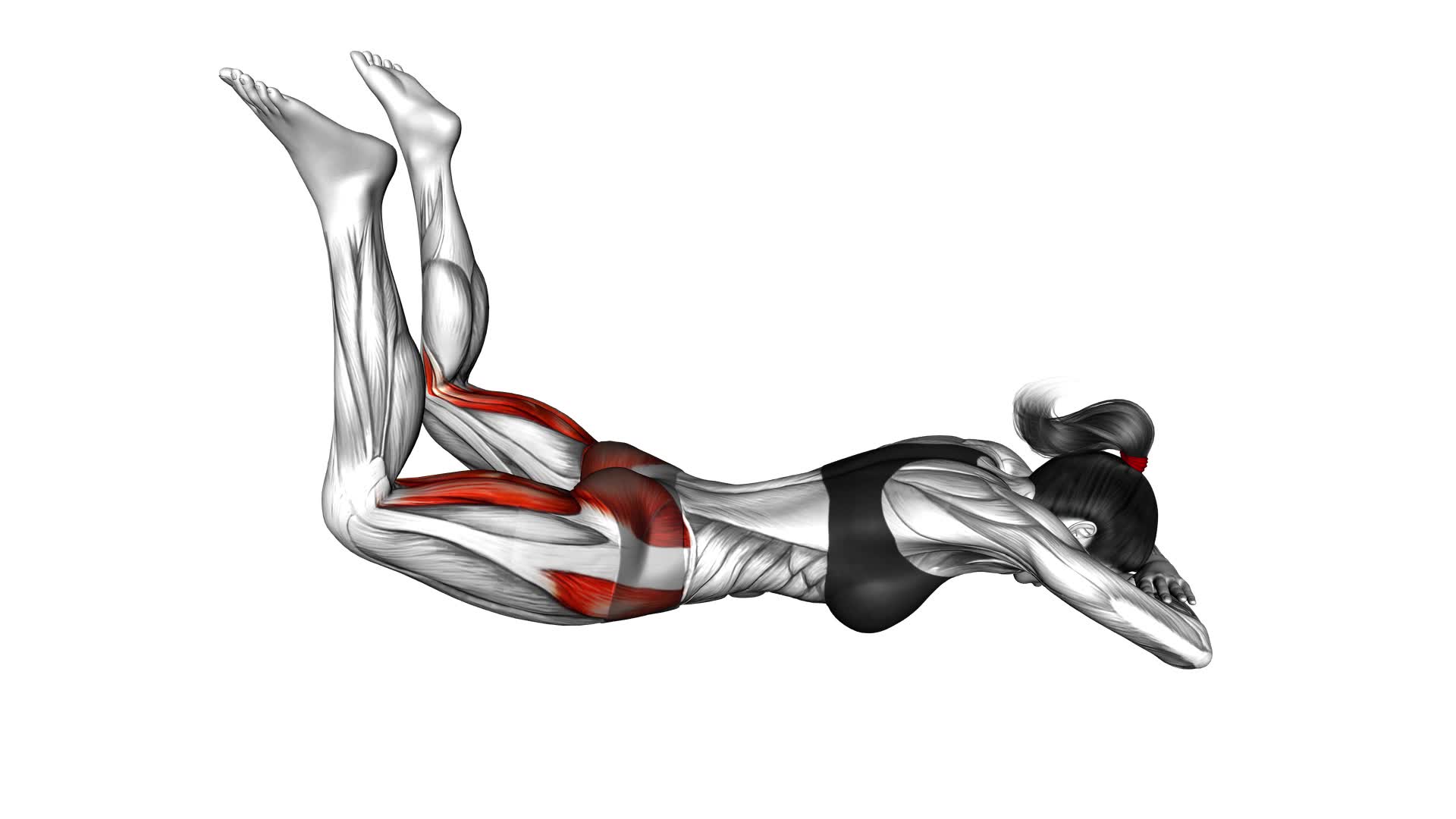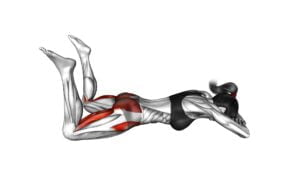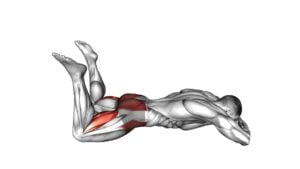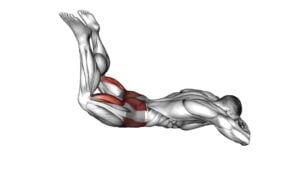Lying Frog Kick (female) – Video Exercise Guide & Tips

Are you looking for a powerful exercise to tone your lower body muscles? Look no further than the lying frog kick!
Watch This Exercise Video
This video exercise guide and tips will show you how to perform the lying frog kick with proper form and technique. Whether you're a beginner or advanced, this exercise can be modified to suit your fitness level.
Learn about common mistakes to avoid and get ready to maximize your results with the lying frog kick.
Let's get started!
Key Takeaways
- The lying frog kick exercise is beneficial for improving core strength and targeting lower abdominal muscles.
- Proper form and technique include maintaining a neutral spine, slowly raising legs off the ground, pressing feet together, and breathing steadily.
- Beginners can modify the exercise by starting with bent legs at a smaller angle, while advanced levels can add resistance or increase the angle of leg extension.
- Common mistakes to avoid include rushing through the exercise, lifting the head and shoulders off the ground, neglecting breathing rhythm, and overextending the legs.
Benefits of the Lying Frog Kick Exercise
Discover the numerous benefits of the Lying Frog Kick exercise for improving core strength and targeting the lower abdominal muscles.
The Lying Frog Kick is a highly effective exercise that activates multiple muscle groups in your body. During the movement, the primary muscles engaged are the rectus abdominis, obliques, and hip flexors. These muscles work together to stabilize your core and generate the kicking motion.
Muscle activation during the Lying Frog Kick is intense and focused. As you extend your legs outwards and bring them back in, your lower abdominal muscles are continuously engaged, helping to strengthen and tone them. This exercise also activates your hip flexors, which play a crucial role in stabilizing your pelvis and lower back.
Incorporating the Lying Frog Kick into a full body workout routine can yield even greater benefits. By combining it with other exercises that target different muscle groups, such as squats or push-ups, you can create a comprehensive workout that engages your entire body. This won't only improve your core strength but also enhance overall muscle tone and increase calorie burn.
Proper Form and Technique for Lying Frog Kick
To perform the Lying Frog Kick exercise with proper form and technique, position yourself on your back with your legs extended and your arms by your sides. This exercise is commonly misunderstood, so let's clear up some misconceptions.
Here are some key points to keep in mind when performing the Lying Frog Kick:
- Maintain a neutral spine throughout the exercise, engaging your core muscles to stabilize your body.
- Slowly raise your legs off the ground, bending at the knees and bringing your heels towards your glutes.
- Press your feet together and squeeze your glutes as you extend your legs outward, mimicking the motion of a frog kicking its legs.
- Remember to breathe steadily throughout the exercise, exhaling as you extend your legs and inhaling as you bring them back in.
- Keep the movement controlled and avoid any jerking or swinging motions.
To progress this exercise, you can add ankle weights or resistance bands to increase the resistance. Variations of the Lying Frog Kick include performing the exercise with a stability ball between your legs or adding a hip thrust at the top of each repetition.
Modifications for Beginners and Advanced Levels
For beginners and advanced levels, there are several modifications you can make to the Lying Frog Kick exercise. These modifications cater to different fitness levels and provide variations of the exercise to challenge your body in different ways.
For beginners, you can start by performing the exercise with your legs bent at a smaller angle. Instead of fully extending your legs, you can keep them slightly bent to reduce the difficulty and strain on your lower back and hip flexors. As you build strength and flexibility, you can gradually increase the angle of your leg extension.
For advanced levels, you can make the exercise more challenging by adding ankle weights or resistance bands. These additional weights or resistance will increase the resistance on your hip flexors and glutes, making the exercise more intense and effective in toning and strengthening those muscles.
By modifying the Lying Frog Kick exercise to suit your fitness level, you can ensure that you're working at an appropriate intensity and avoiding unnecessary strain or injury.
Now, let's move on to the next section and discuss some common mistakes to avoid during the Lying Frog Kick exercise.
Common Mistakes to Avoid During Lying Frog Kick
One mistake to avoid during the Lying Frog Kick exercise is overextending your legs, as this can strain your lower back and hip flexors. To ensure you perform the exercise correctly and avoid injury, here are some common mistakes to avoid:
- Rushing through the exercise: Take your time and focus on proper form and control throughout the movement.
- Lifting your head and shoulders off the ground: Keep your upper body relaxed and maintain contact with the floor to engage your core effectively.
- Neglecting your breathing: Remember to breathe in as you lower your legs and exhale as you bring them back up, maintaining a steady rhythm.
By avoiding these mistakes, you can perform the Lying Frog Kick exercise safely and effectively.
Now, let's move on to the next section to discover some valuable tips for maximizing your results with the lying frog kick.
Tips for Maximizing Results With Lying Frog Kick
To maximize your results with the Lying Frog Kick, focus on maintaining proper form and control throughout the exercise. This will ensure that you're effectively engaging the targeted muscle groups.
One tip for maximizing muscle engagement is to squeeze your glutes and core muscles as you lift your legs off the ground. This will help to activate and strengthen these areas.
Additionally, you can vary the exercise to target different muscle groups. For example, by extending your legs straight up instead of bending them, you'll engage your hip flexors and lower abs more intensely.
To further challenge your core muscles, you can try adding a twist to the movement by crossing your legs over each other. This will work your obliques and enhance your overall stability.
By incorporating these variations and focusing on maintaining proper form and control, you'll optimize the effectiveness of the Lying Frog Kick and achieve better results.
Now, let's move on to a sample lying frog kick workout routine.
Sample Lying Frog Kick Workout Routine
To continue maximizing your results with the Lying Frog Kick, incorporate the following sample workout routine:
- Start with a warm-up: Perform 5-10 minutes of light cardio, such as walking or jogging, to get your blood flowing and prepare your muscles for the upcoming workout.
- Lying Frog Kick variations: To target different muscles and add variety to your routine, try these variations:
- Single-leg Lying Frog Kick: Perform the exercise with one leg at a time, focusing on maintaining proper form and engaging the glutes and core.
- Resistance band Lying Frog Kick: Place a resistance band around your ankles and perform the exercise, adding resistance to increase the challenge.
- Lying Frog Kick with a stability ball: Place a stability ball between your feet and perform the exercise, engaging your core and improving stability.
- Lying Frog Kick muscles worked: This exercise primarily targets the glutes, specifically the gluteus maximus, which is the largest muscle in the buttocks. It also engages the hip flexors, hamstrings, and core muscles.
Incorporating these lying frog kick variations and understanding the muscles worked will help you create a well-rounded workout routine that challenges your muscles in different ways. Remember to listen to your body and adjust the intensity and difficulty as needed.
Stay consistent and enjoy the benefits of a strong and toned lower body.
Frequently Asked Questions
How Many Calories Does the Lying Frog Kick Exercise Burn?
The lying frog kick exercise is a great way to burn calories and tone your muscles. It targets your abs, legs, and glutes, helping you build strength and endurance. While the exact number of calories burned depends on factors like your weight and intensity, this exercise can help you burn a significant amount of calories.
To make it more challenging, you can try variations like adding ankle weights or using a stability ball.
Can the Lying Frog Kick Exercise Help With Weight Loss?
The lying frog kick exercise can definitely help with weight loss. It targets the lower body muscles and burns calories. By incorporating modifications like increasing the intensity or adding resistance, you can maximize the benefits.
However, keep in mind that weight loss also depends on other factors like diet and overall exercise routine. If you're looking for the best exercises for weight loss, the lying frog kick is a great addition to your fitness regimen.
What Muscles Does the Lying Frog Kick Exercise Target?
The lying frog kick exercise primarily targets your abdominal muscles, specifically the rectus abdominis and the obliques. This exercise is great for strengthening your core and improving stability.
To perform the lying frog kick, lie on your back with your legs extended and arms by your sides. Bend your knees and bring your feet together, then open your knees out to the sides, resembling a frog's legs.
This exercise has variations that can challenge your core even more. Remember to maintain proper form throughout.
How Often Should I Incorporate the Lying Frog Kick Exercise Into My Workout Routine?
To effectively incorporate the lying frog kick exercise into your workout routine, it's important to consider your fitness level and goals.
Beginners can modify this exercise by starting with smaller movements and gradually increasing the range of motion.
By incorporating the lying frog kick exercise into a Pilates routine, you can strengthen and tone your core, glutes, and inner thighs.
Aim to perform this exercise 2-3 times a week for optimal results.
Can the Lying Frog Kick Exercise Be Beneficial for Individuals With Lower Back Pain?
The lying frog kick exercise can indeed be beneficial for individuals with lower back pain. By engaging the core muscles and stretching the lower back, this exercise can help improve strength and flexibility in the area.
However, if you experience discomfort or pain during the movement, it's important to modify or choose alternative exercises that are more suitable for your condition.
Consulting with a healthcare professional or a certified trainer can provide you with specific lying frog kick modifications or alternative exercises that can help alleviate lower back pain.
Conclusion
In conclusion, the lying frog kick exercise is a beneficial workout for improving core strength and flexibility. By maintaining proper form and technique, beginners and advanced individuals can both benefit from this exercise.
It's important to avoid common mistakes and follow the provided tips to maximize results. Incorporating the lying frog kick into a workout routine can lead to improved overall fitness.

Author
Years ago, the spark of my life’s passion ignited in my mind the moment I stepped into the local gym for the first time. The inaugural bead of perspiration, the initial endeavor, the very first surge of endorphins, and a sense of pride that washed over me post-workout marked the beginning of my deep-seated interest in strength sports, fitness, and sports nutrition. This very curiosity blossomed rapidly into a profound fascination, propelling me to earn a Master’s degree in Physical Education from the Academy of Physical Education in Krakow, followed by a Sports Manager diploma from the Jagiellonian University. My journey of growth led me to gain more specialized qualifications, such as being a certified personal trainer with a focus on sports dietetics, a lifeguard, and an instructor for wellness and corrective gymnastics. Theoretical knowledge paired seamlessly with practical experience, reinforcing my belief that the transformation of individuals under my guidance was also a reflection of my personal growth. This belief holds true even today. Each day, I strive to push the boundaries and explore new realms. These realms gently elevate me to greater heights. The unique combination of passion for my field and the continuous quest for growth fuels my drive to break new ground.







